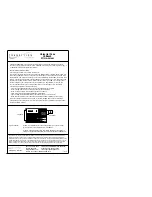
NEO-D9C - Integration manual
In this mode only UART1 communication is possible. For communication via UART1 in safe boot
mode, the host must send a training sequence (0x55 0x55 at 9600 baud) to the receiver in order to
begin communication. After this the host must wait at least 2 ms before sending any data.
It is recommended to have the possibility to pull the SAFEBOOT_N pin low in the application. This
can be provided using an externally connected test point or a host I/O port.
3.3.4 Extended TX timeout
If the host does not communicate over SPI or I2C for more than approximately 2 seconds, the device
assumes that the host is no longer using this interface and no more packets are scheduled for
this port. This mechanism can be changed by enabling "extended TX timeouts", in which case the
receiver delays idling the port until the allocated and undelivered bytes for this port reach 4 kB. This
feature is especially useful when using the TX-READY feature with a message output rate of less
than once per second, and polling data only when data is available, determined by the TX_READY
pin becoming active.
3.4 Security
3.4.1 Receiver status monitoring
Messages in the UBX class UBX-MON are used to report the status of the parts of the embedded
computer system that are not related to the received satellite system specific info.
The main purposes are:
• Hardware and software versions, using UBX-MON-VER.
3.5 Forcing a receiver reset
The NEO-D9C is not a GNSS receiver and does not operate to the same principles as a standard
GNSS. However it does support the standard UBX-CFG-RST command.
Data stored in flash memory is not cleared by any of the options provided by UBX-CFG-RST.
The
resetMode
must be specified. This is not related to QZSS, but to the way the software restarts
the system.
•
Hardware reset (watchdog), immediately
uses the on-chip watchdog, in order to electrically
reset the chip. This is an immediate, asynchronous reset. No Stop events are generated.
•
Controlled software reset
terminates all running processes in an orderly manner and, once
the system is idle, restarts operation, reloads its configuration and starts to acquire and track
QZSS satellites.
•
Hardware reset (watchdog), after shutdown
uses the on-chip watchdog, in order to electrically
reset the chip after shutdown.
3.6 Firmware upload
NEO-D9C is supplied with firmware. u-blox may release updated images containing, for example,
security fixes, enhancements, bug fixes, etc. Therefore it is important that customers implement a
firmware update mechanism in their system.
A firmware image is a binary file containing the software to be run by the GNSS receiver. A firmware
update is the process of transferring a firmware image to the receiver and storing it in non-volatile
flash memory.
UBX-21031631 - R02
3 Receiver functionality
Page 22 of 53
C1-Public
















































